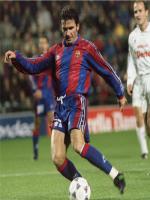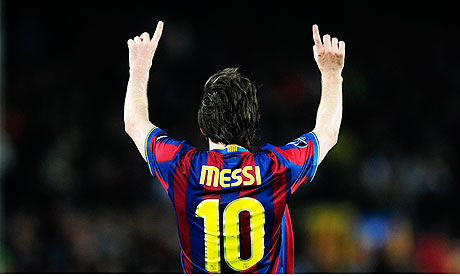This is a Hitskin.com skin preview
Install the skin • Return to the skin page
Tactical Review of the 2010-11 Season
5 posters
Page 1 of 1
 Tactical Review of the 2010-11 Season
Tactical Review of the 2010-11 Season
This was a season in which club football asserted its primacy, and the false nine came from the periphery into the mainstream
Barcelona's Lionel Messi wears No10 but has spearheaded the tactical vogue for a false nine.
The closer you are, of course, the harder it is to step back and see the overall pattern. After Internazionale, cautious and canny and playing within themselves, had won the European Cup, and after a World Cup of a miserable lack of adventure, there seemed a possibility that football might be entering a new age of caution.
It wasn't. As in 2004, when José Mourinho's Porto had won the Champions League and Greece had lifted the European Championship, the lessons of the summer seemed to have been forgotten by the time the new season came around. Perhaps, as Jorge Valdano has suggested, it is simply that in the televisual age that clubs feel a barely expressed need to satisfy their audiences – which entails some combination of winning and entertaining.
More sinisterly – at least if you're a country that has just committed to a vast programme of infrastructure development to host a World Cup – there is a clear gulf both in quality and entertainment value between club and international football (even if, for now, TV viewing figures remain much higher for international than club football). Football these days is highly systematised; it's not about individuals. That means players must have a mutual understanding, must know that if they go forward somebody else will cover, must know who is likely to move where and when. It is that understanding that gives them the fraction of a second advantage that allows them to break highly coherent defences.
At international level, there simply isn't the time to generate that level of understanding. Coaches – unless they are Marcelo Bielsa – become more cautious. Sticking men behind the ball is relatively easy; far harder to work out how to cover if some of those players are to make forward runs. The result is the "broken teams" that characterised the World Cup – six or seven players whose prime job was to sit deep; four or three who played high up the field, with very little in between. Only Spain transcended that, largely because their personnel and style is so heavily based upon Barcelona, and even they, faced with massed defences, failed to thrill.
After the World Cup, there was something almost refreshing about the early weeks of the domestic season, not least – in England – because even the promoted sides were largely committed to attacking. This has been a growing trend – the total goals scored by the relegated clubs from 2005 reads 85, 95, 107, 104, 110 and then 135 this season – but Blackpool were still a revelation: to quibble, as many have, that their defence wasn't good enough ( and 78 goals is a lot to have conceded) is rather to miss the point.
Blackpool's 4-3-3, with Charlie Adam spraying long diagonal passes from deep, was highly effective. It caught teams by surprise and earned Blackpool a raft of points early in the season that even they probably didn't expect. No team in the Premier League era has been relegated scoring as many as 55 goals (Middlesbrough in 1992-93 are the only other side to have broken the half-century, and they had four more games to do it in), and a goal difference of -23 is nothing to be ashamed of – in 2009-10, six teams had a worse record than that.
Later on, as opponents became wise to it, and injuries and suspensions bit into the Premier League's shallowest squad, Blackpool struggled, but they still ended up with twice as many points as most predicted. Ian Holloway's approach was unorthodox and unexpected and it very nearly worked. Just because he reasoned his best chance was to play open, attacking football rather than following the paradigm of the promoted manager by looking to keep things tight and nick the odd 1-0 here and there doesn't make it any less of a tactical achievement, and hopefully his example – and that of Newcastle United and West Bromwich Albion, who both began the season with similarly positive intent – will inspire other newly promoted sides not to retreat into their shell as a first reaction.
At the other end of the scale, this season has confirmed the effectiveness of the false nine. Lionel Messi has been majestic in the role, dropping off from a natural striking role to link with the midfield, vacating space for others to break into. Carlos Tevez has interpreted it in a slightly different way at Manchester City, linking two halves of a broken team, at least until Yaya Touré became more expansive later on in the season.
Perhaps it's significant that the two prime exponents of the art are Argentinian (although Alexander Kerzhakov performed the role superbly for Zenit St Petersburg last season). It's tempting to believe that so intense is the desire in Argentina to preserve the pibe tradition and protect the role of el diez, that they're prepared to sacrifice el nueve to do so. Boca Juniors, of course, continue to try to keep both alive, but watching the 32-year-old Juan Román Riquelme sparkling fitfully behind the lumbering 37-year-old, Martín Palermo, makes it feel a bit like the Bombonera has been taken over by the Sealed Knot.
Alongside the false nine goes inverted wingers; players who begin wide and look to cut into the space left by the backward movement of the centre-forward. They had become a trend anyway; André Villas-Boas's use of Hulk, a player commonly used as a centre-forward in the past, cutting in from the right flank, is an example of the inverted winger being played with a more orthodox centre-forward. Long term, though, they seem a more natural fit with the false nine, offering in-built fluidity as they instinctively cut into the space the central player has created by dropping deep.
The other eye-catching tactical shift this season, in England at least, has been Wayne Rooney's redeployment as a second striker. He perhaps could have become a false nine himself – he has the ability and the instinct to fall back from the front line – but instead he's evolved a unique role, and by so doing may have shown a way that 4-4-2 can survive as a formation at the highest level (essentially by becoming 4-4-1-1 where the second striker is almost a reverse libero, given licence to drop off the front and go hunting the ball and space, rather than stepping out from the back). It remains to be seen whether other players can ape him, or whether Rooney is sui generis, but the use of the second striker as the midfield tackler feels like a logical development of the use of wide forwards as primarily blocking players.
This season has also seen Liverpool and Sunderland experiment with three at the back in specific circumstances – evidence of the Premier League's growing tactical flexibility, while Napoli showed how effective wing-backs can be against opponents who insist on playing narrow, as so many teams in Italy do. Inter's humiliation at the hands of Schalke 04 in the Champions League, when the two full-backs, Atsuto Uchida and Hans Sarpei ran riot, will perhaps jolt Serie A into looking to the future rather than looking constantly back 15 years.
At the very highest level, though, this was a season in which club football asserted its primacy, and the false nine came from the periphery into the mainstream.
Original article can be read here:
Jonathan Wilson

Gaudiola- Prospect

- Posts : 46
Join date : 2011-06-05
 Re: Tactical Review of the 2010-11 Season
Re: Tactical Review of the 2010-11 Season
I enjoyed reading that, not bad.
Though, I dont understand why it is suggested that Rooney dropping in between the lines and allowing the 4-4-2 to still be a workable formation via the 4-4-1-1 is something unique or new.
Teams have been doing that for a VERY long time, Manchester Utd under S.A.F have done that a long time ago.
Though, I dont understand why it is suggested that Rooney dropping in between the lines and allowing the 4-4-2 to still be a workable formation via the 4-4-1-1 is something unique or new.
Teams have been doing that for a VERY long time, Manchester Utd under S.A.F have done that a long time ago.

The Franchise- Admin

- Club Supported :

Posts : 19651
Join date : 2011-06-05
Age : 37
 Re: Tactical Review of the 2010-11 Season
Re: Tactical Review of the 2010-11 Season
not one thing about madrid?

The Madrid One- "Imaybeonthesideoftheangels..."
- Club Supported :

Posts : 4947
Join date : 2011-06-05
Age : 30
 Re: Tactical Review of the 2010-11 Season
Re: Tactical Review of the 2010-11 Season
The Franchise wrote:I enjoyed reading that, not bad.
Though, I dont understand why it is suggested that Rooney dropping in between the lines and allowing the 4-4-2 to still be a workable formation via the 4-4-1-1 is something unique or new.
Teams have been doing that for a VERY long time, Manchester Utd under S.A.F have done that a long time ago.
Question is... Rooney did that before?

Gaudiola- Prospect

- Posts : 46
Join date : 2011-06-05
 Re: Tactical Review of the 2010-11 Season
Re: Tactical Review of the 2010-11 Season
The Madrid One wrote:not one thing about madrid?
I'm sorry. I'm not reading any football based Madrid papers; I'll let you know when I will...
Regards!

Gaudiola- Prospect

- Posts : 46
Join date : 2011-06-05
 Re: Tactical Review of the 2010-11 Season
Re: Tactical Review of the 2010-11 Season
What is there to tactically say about Madrid?
Serious question, what did you do so unique or at least memorable?
Serious question, what did you do so unique or at least memorable?

The Franchise- Admin

- Club Supported :

Posts : 19651
Join date : 2011-06-05
Age : 37
 Re: Tactical Review of the 2010-11 Season
Re: Tactical Review of the 2010-11 Season
The Franchise wrote:What is there to tactically say about Madrid?
Serious question, what did you do so unique or at least memorable?
I'll answer that for you, nothing of note...
Another tactical development...Inverted wingers seem to have cooled off a bit after last year when everyone and their mothers was using them

Swanhends- Fan Favorite

- Club Supported :

Posts : 8451
Join date : 2011-06-05
 Re: Tactical Review of the 2010-11 Season
Re: Tactical Review of the 2010-11 Season
The article mentions that at least for now, international audiences are not decreasing, and implying that they will in the future. I don't think that's the case at all. I realize that in a lot of European countries some people prefer to watch clubs > national teams, but in the end of the day you're still going to watch them because they represent you whether they entertain or not. Certainly, more people would watch if they played more offensive. However, since they already don't, I doubt they'll see a viewing decline.

BarrileteCosmico- Admin

- Club Supported :

Posts : 28336
Join date : 2011-06-05
Age : 34
 Similar topics
Similar topics» Season in Review
» The Blue Box
» Season Review
» Season in review!
» 2011-12 season review, what do you make of it?
» The Blue Box
» Season Review
» Season in review!
» 2011-12 season review, what do you make of it?
Page 1 of 1
Permissions in this forum:
You cannot reply to topics in this forum|
|
|
 Hitskin.com
Hitskin.com

» Mbappe to Real Madrid - Official
» Erik Ten Hag Sack Watch
» The Lionel Messi Appreciation Thread & Fan Club IV
» MLS-thread
» Champions League '24/25
» GL NBA fantasy 24-25
» General Games Discussion
» Premier League 2024/25
» Jose Mourinho Sack Watch: Fenerbahce Edition
» La Liga 2024/25
» Bundesliga 2024/25
» The official Tennis thread